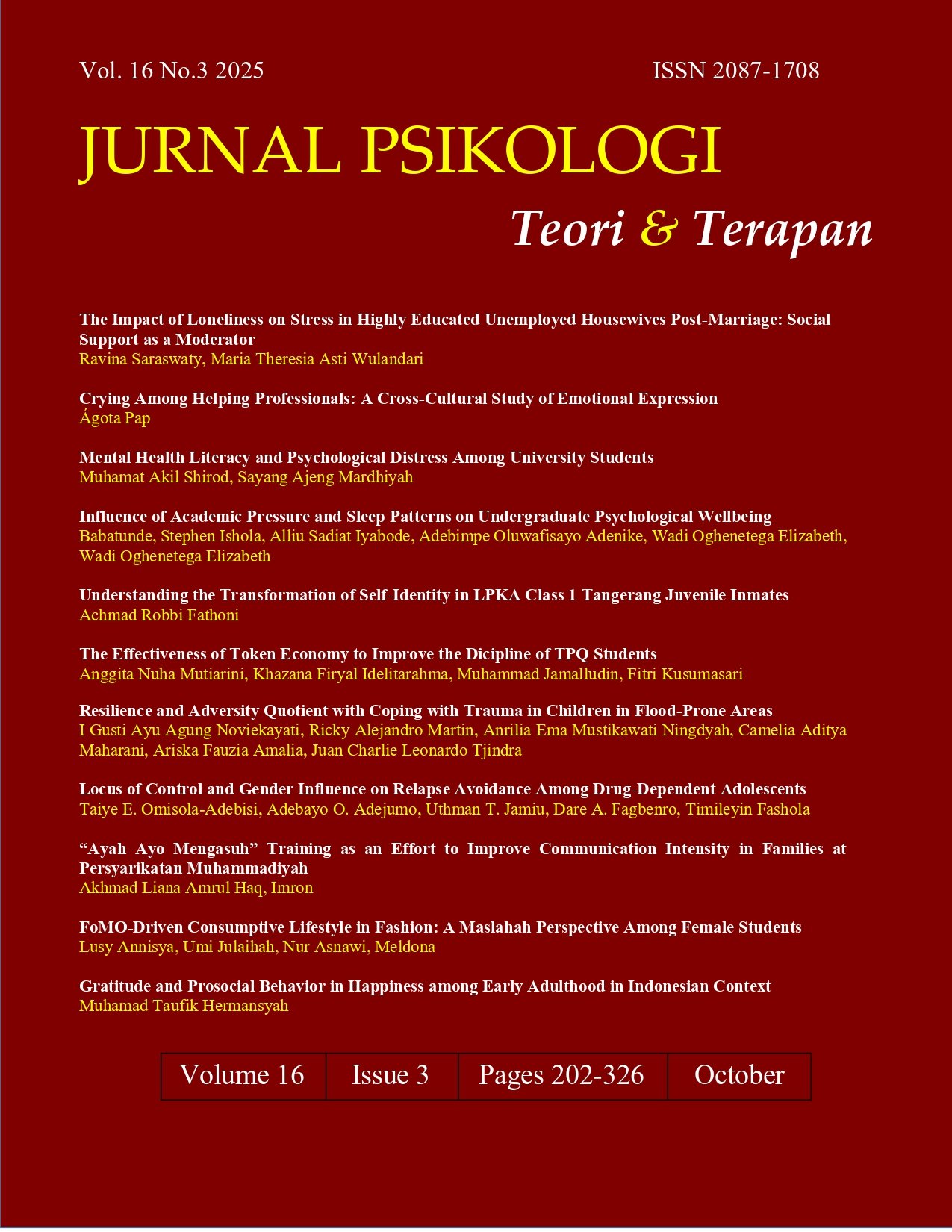The Impact of Loneliness on Stress in Highly Educated Unemployed Housewives Post-Marriage: Social Support as a Moderator
DOI:
https://doi.org/10.26740/jptt.v16n03.p202-216Keywords:
Higher education, loneliness, social support, stress, unemployed housewivesAbstract
Background: Individuals with higher educational backgrounds often hold higher standards in evaluating social relationships, making them more vulnerable to isolation when intellectual and emotional support is lacking. Objective: This study aims to examine the effect of loneliness on stress among highly educated, non-working housewives and to explore the moderating role of social support. Method: A non-experimental cross-sectional design was used with a non-probability convenience sampling technique. Participants were housewives aged 25–40. Data were collected using validated questionnaires: MSPSS, UCLA Loneliness Scale (Version 3), and PSS-10. Results: Loneliness showed a positive significant relationship with stress, indicating higher loneliness correlates with higher stress. The regression coefficient for social support in relation to stress was significantly positive, meanwhile social support negatively correlated with loneliness but did not significantly affect stress or moderate the relationship between loneliness and stress. Conclusion: The study concludes that loneliness significantly contributes to increased stress, while social support does not significantly reduce stress, possibly due to other moderating factors like relationship quality or personality traits.
Abstrak
Latar belakang: Individu dengan pendidikan tinggi cenderung memiliki standar tinggi dalam menjalin relasi sosial, sehingga lebih rentan mengalami isolasi saat dukungan intelektual dan emosional kurang. Tujuan: Meneliti pengaruh kesepian terhadap stres pada ibu rumah tangga berpendidikan tinggi yang tidak bekerja, serta mengeksplorasi peran moderasi dukungan sosial. Metode: Penelitian kuantitatif dengan desain potong lintang dan teknik convenience sampling. Partisipan adalah ibu rumah tangga usia 25–40 tahun, minimal lulusan diploma, tidak bekerja atau berhenti bekerja setelah menikah, hanya mengurus rumah tangga, telah menikah minimal tiga tahun, dan memiliki pengalaman kerja minimal satu tahun. Instrumen yang digunakan yaitu MSPSS, UCLA Loneliness Scale versi 3, dan PSS-10. Hasil: Kesepian berhubungan positif dan signifikan dengan stres, menunjukkan semakin tinggi kesepian, semakin tinggi stres. Dukungan sosial berkorelasi negatif dengan kesepian, tetapi tidak berpengaruh signifikan terhadap stres maupun memoderasi hubungan kesepian dan stres. Kesimpulan: Kesepian berkontribusi signifikan terhadap stres, sementara dukungan sosial tidak berperan sebagai pelindung, kemungkinan dipengaruhi oleh faktor lain seperti kualitas hubungan atau kepribadian.
References
Ani. (2017). Perempuan dan karir (Telaah teori trait and factor dalam pengembangan karir dan pengambilan
keputusan). Muwazah: Jurnal Studi Gender, 9(2), 117–130. https://e-journal.uingusdur.ac.id/Muwazah/article/view/9002
Antonucci, T. C., Ajrouch, K. J., & Birditt, K. S. (2014). The convoy model:Explaining social relations from
A multidisciplinary perspective. The Gerontologist, 54(1), 82–92. https://doi.org/10.1093/geront/gnt118
Ardiansyah, I., Jailani, A., & Isma, M. (2024). Pergeseran paradigma sosial tentang pendidikan perempuan di
Indonesia: Implikasi terhadap peran dan kesempatan perempuan dalam pendidikan. Jurnal Pendidikan dan Sosial Budaya, 12(2), 45-58.
Badan Pusat Statistik (BPS). (2021). Statistik Pendidikan 2021. Badan Pusat Statistik.
Allen, T. D., French, K. A., Dumani, S., & Shockley, K. M. (2015). Meta-analysis of work–family
conflict mean differences: Does the national context matter? Journal of Vocational Behavior,
90, 90–100. https://doi.org/10.1016/j.jvb.2015.07.006
Bolger, N., & Amarel, D. (2007). Effects of social support visibility on adjustment to stress: Experimental
evidence. Journal of Personality and Social Psychology, 92(3), 458–475. https://doi.org/10.1037/0022-3514.92.3.458
Cacioppo, J. T., & Cacioppo, S. (2018). The growing problem of loneliness is a major concern. American Psychologist, 73(5),
297-309. https://doi.org/10.1037/amp0000304
Cohen, S., & Wills, T. A. (1985). Stress, social support, and the buffering hypothesis. Psychological
Bulletin, 98(2), 310–357. https://doi.org/10.1037/0033-2909.98.2.310
Cacioppo, J. T., Cacioppo, S., & Capitanio, P., & Cole, S. W. (2015). The neuroendocrinology of social
isolation. Annual Review of Psychology, 66, 733–767. https://doi.org/10.1146/annurev-psych-010814-015240
Carstensen, L. L. (1995). Evidence for a life-span theory of socioemotional selectivity. Current Directions in
Psychological Science, 4(5), 151-156. https://doi.org/10.1111/1467-8721.ep10770512
Cohen, S. (2004). Social relationships and health. American Psychologist, 59(8), 676-684.
https://doi.org/10.1037/0003-066X.59.8.676
Cornwell, E. Y., & Waite, L. J. (2009). Social disconnectedness, perceived isolation, and health among older
adults. Journal of Health and Social Behavior, 50(1), 31–48. https://doi.org/10.1177/002214650905000103
Cho, E., Tay, L., Allen, T. D., & Stark, S. (2013). Identification of a dispositional tendency to
experience work–family conflict. Journal of Vocational Behavior, 82(3), 188–198.
Cohen, S., & Wills, T. A. (1985). Stress, social support, and the buffering hypothesis. Psychological
Bulletin, 98(2), 310–357. https://doi.org/10.1037/0033-2909.98.2.310
Taylor, S. E., & Stanton, A. L. (2007). Coping resources, coping processes, and mental health.
Annual Review of Clinical Psychology, 3, 377–401.
https://doi.org/10.1146/annurev.clinpsy.3.022806.091520
Ebstrup, J. F., Eplov, L. F., Pisinger, C., & Jørgensen, T. (2011). Association between the five factor
personality traits and perceived stress: is the effect mediated by general self-efficacy? Anxiety, Stress, & Coping, 24(4), 407–419. https://doi.org/10.1080/10615806.2010.540012
Fajriyati, L., Lestari, S., & Hertinjung, A. (2023). Representasi peran gender dalam keluarga: Telaah
budaya patriarki di Indonesia. Jurnal Sosiologi DILEMA, 38(1), 45–58
Green, M., Ang, L. S., & Tan, S. Y. (2021). Perceptions of intellectual isolation among stay-at-home
mothers: The role of social support. Journal of Social and Clinical Psychology, 40(2), 121-135.
https://doi.org/10.1521/jscp.2021.40.2.121
Chen, Y., & Feeley, T. H. (2014). Social support, social strain, loneliness, and well-
being among older adults: An analysis of the Health and Retirement Study. Journal of
Social and Personal Relationships, 31(2), 141–161.
https://doi.org/10.1177/0265407513488728
Hobfoll, S. E., Tirone, V., Holmgreen, L., & Gerhart, J. (2016). Conservation of Resources
Theory applied to major stress. In Stress: Concepts, Cognition, Emotion, and Behavior (pp.
65–71). Academic Press. https://doi.org/10.1016/B978-0-12-800951-2.00007-8
Haslam, C., McMahon, C., Cruwys, T., Haslam, S. A., & Steffens, N. K. (2018). Social group memberships
and postnatal maternal well-being: A longitudinal study. Journal of Reproductive and Infant Psychology, 36(2), 173–181. https://doi.org/10.1080/02646838.2018.1424116
Hawkley, L. C., & Capitanio, J. P. (2015). Perceived social isolation, evolutionary fitness and health
outcomes: A lifespan approach. Philosophical Transactions of the Royal Society B: Biological Sciences, 370(1669), 20140114. https://doi.org/10.1098/rstb.2014.0114
Hawkley, L. C., & Cacioppo, J. T. (2010). Loneliness matters: A theoretical and empirical review of
consequences and mechanisms. Annals of Behavioral Medicine, 40(2), 218–227. https://doi.org/10.1007/s12160-010-9210-8
Heinrich, L. M., & Gullone, E. (2006). The clinical significance of loneliness: A literature review. Clinical
Psychology Review, 26(6), 695–718. https://doi.org/10.1016/j.cpr.2006.04.002
House, J. S., Umberson, D., & Landis, K. R. (1988). Structures and processes of social support. Annual
Review of Sociology, 14, 293–318. https://doi.org/10.1146/annurev.so.14.080188.001453
Hewlett, B. S., & Luce, T. (2005). The role of women in the modern family: Perspectives from socio-cultural
anthropology. Gender and Society, 19(3), 427-450. https://doi.org/10.1177/0891243205275142
Hidayati, S., Dwianto, A., & Andriana, A. (2021). Stres pada ibu rumah
tangga berpendidikan tinggi: Faktor risiko dan dampaknya terhadap kesehatan mental. Jurnal Psikologi Indonesia, 16(1), 44-58. https://doi.org/10.1007/jpsikologi.16.1.44
Holt-Lunstad, J., Smith, T. B., & Layton, J. B. (2010). Social relationships and mortality risk: A meta-
analytic review. PLOS Medicine, 7(7), e1000316. https://doi.org/10.1371/journal.pmed.1000316
Kaplan, D. (2023). Persepsi diri dan kualitas hidup ibu rumah tangga berpendidikan tinggi. Journal of
Applied Psychology, 35(4), 380-397. https://doi.org/10.1016/j.applpsychol.2023.04.004
Kossek, E. E., & Ozeki, C. (2008). Work–family conflict, policies, and the job–life
satisfaction relationship: A review and directions for organizational behavior–human
resources research. Journal of Applied Psychology, 93(1), 39–58.
Luhmann, M., & Hawkley, L. C. (2016). Age differences in loneliness from late adolescence to oldest old
age. Developmental Psychology, 52(6), 943–959. https://doi.org/10.1037/dev0000117
Lupton, D. (2002). The new parenting: Modern approaches to family life in the changing world. Sociological
Research, 49(4), 33-45.https://doi.org/10.1007/sociologicalresearch.49.4.33
Luo, Y., Hawkley, L. C., Waite, L. J., & Cacioppo, J. T. (2012). Loneliness, health, and mortality in old age:
A national longitudinal study. Social Science & Medicine, 74(6), 907–914. https://doi.org/10.1016/j.socscimed.2011.11.028
Mariyanti, R., Suryani, E., & Pratiwi, P. (2021). Optimisme ibu bekerja dengan tiga anak ke atas ditinjau dari
dukungan keluarga dan resiliensi. Jurnal Psikologi Insight, 3(2), 99–108. https://doi.org/10.24198/insight.v3n2.2021.99-108
Mariyanti, R., Wahyudi, T., & Ratnasari, A. (2021). The emotional challenges of highly educated stay-at-
home mothers: A qualitative study. Psychology and Gender Studies Journal, 7(3), 59-71. https://doi.org/10.1111/pgsj.2021.7.3.59
Matud, M. P. (2004). Gender differences in stress and coping styles. Personality and Individual Differences,
37(7), 1401–1415. https://doi.org/10.1016/j.paid.2004.01.010
Mund, M., Freuding, M. M., Möbius, K., Horn, N., & Neyer, F. J. (2020). The stability and change of
loneliness across the life span: A meta-analysis of longitudinal studies. Personality and Social Psychology Review, 24(1), 24–52. https://doi.org/10.1177/1088868319850738
Neighbour, R. (1985). The Inner Consultation: How to Develop an Effective and Intuitive Consulting Style.
London: Kluwer Academic Publishers.
Neff, L. A., & Karney, B. R. (2005). To know you is to love you: The implications of global adoration and
specific accuracy for marital relationships. Journal of Personality and Social Psychology, 88(3),
480–497. https://doi.org/10.1037/0022-3514.88.3.480
Nomaguchi, K. M., & Milkie, M. A. (2003). Costs and rewards of children: The effects of becoming a parent
on adults’ lives. Journal of Marriage and Family, 65(2), 356–374.
Paulhus, D. L. (1984). Two-component models of socially desirable responding. Journal of Personality and
Social Psychology, 46(3), 598–609. https://doi.org/10.1037/0022-3514.46.3.598
Perlman, D., & Peplau, L. A. (1981). Toward a social psychology of loneliness. In R. Gilmour & S. Duck
(Eds.), Personal relationships in disorder (pp. 31–56). Academic Press.
Peplau, L. A., & Perlman, D. (1982). Loneliness: A sourcebook of current theory, research, and therapy.
Wiley.
Rubin, D., & Wooten, S. (2007). Stres ibu rumah tangga: Faktor sosial dan emosional dalam peran domestik.
Journal of Family Psychology, 19(2), 105-118. https://doi.org/10.1037/01915-117.
Rudman, L. A., & Phelan, J. E. (2008). A sociocultural analysis of the impact of education on women’s well-
being. Psychological Review, 115(4), 1019-1034. https://doi.org/10.1037/a0012404
Sahrawat, R. (2024). Pilihan atau tekanan? Dinamika keputusan perempuan menikah dalam memilih untuk
tidak bekerja. Jurnal Psikologi Sosial, 11(2), 134–148.
Sari, L., Pramita, A., & Setiawati, R. (2016). Dampak pekerjaan terhadap perasaan kesepian dan stres pada
ibu rumah tangga berpendidikan tinggi. Jurnal Psikologi Klinis, 14(2), 104-117. https://doi.org/10.2121/jpsikologiklinis.14.2.104
Schmitt, D. P., Realo, A., & Voracek, M. (2008). Gender and personality traits: The psychological and
cultural context of gender differences. Psychological Science, 19(1), 12-26.
Simon, R. W. (2002). Revisiting the relationships among gender, marital status, and mental health.
American Journal of Sociology, 107(4), 1065–1096. https://doi.org/10.1086/339225
Suparno, F., Lestari, T., & Sari, K. (2023). Pengaruh budaya dan ekspektasi sosial terhadap pilihan karier
perempuan. Jurnal Gender dan Sosial Budaya, 29(1), 91-104. https://doi.org/10.1016/j.jgsb.2023.02.003
Super, D. E. (1980). A life-span, life-space approach to career development. Journal of Vocational Behavior,
16(3), 282–298. https://doi.org/10.1016/0001-8791(80)90056-1
Taslim, N., Ninin, N., & Astuti, D. Y. (2021). Peran budaya terhadap kesejahteraan ibu rumah tangga di
Indonesia. Jurnal Sosial Humaniora, 14(2), 123–134. https://doi.org/10.12962/jsh.v14i2.2021
Taylor, S. E. (2011). Social support: A review. In M. S. Friedman (Ed.), The handbook of health psychology
(pp. 189–214). Oxford University Press.
Taylor, S. E., Repetti, R. L., & Seeman, T. (2000). Health psychology: What is an unhealthy environment
and how does it get under the skin? Annual Review of Psychology, 51, 411–447. https://doi.org/10.1146/annurev.psych.51.1.411
Thoits, P. A. (2011). Mechanisms linking social ties and support to physical and mental health. Journal of
Health and Social Behavior, 52(2), 145–161. https://doi.org/10.1177/0022146510395592
Thoits, P. A. (2011). Social ties and health: A sociological perspective. Journal of Health and Social
Behavior, 52(2), 147-160. https://doi.org/10.1177/0022146510395593
Tıraşoğlu, E., & İpek, İ. (2019). The relationship between personality traits and perceived stress: A study on
Turkish university students. International Journal of Research in Business and Social Science, 8(3),
39–48. https://doi.org/10.20525/ijrbs.v8i3.241
Uchino, B. N. (2006). Social support and health: A review of physiological processes potentially underlying
links to disease outcomes. Journal of Behavioral Medicine, 29(4), 377–387. https://doi.org/10.1007/s10865-006-9056-5
Umberson, D., & Montez, J. K. (2010). Social relationships and health: A flashpoint for health policy.
Journal of Health and Social Behavior, 51(Suppl), S54-S66. https://doi.org/10.1177/0022146510383501
Umberson, D., Pudrovska, T., & Reczek, C. (2010). Parenthood, childlessness, and well-being: A life course
perspective. Journal of Marriage and Family, 72(3), 612–629. https://doi.org/10.1111/j.1741-
3737.2010.00721.x
Utomo, I. D. (2015). Gender, education and occupational aspirations of young Indonesians. Wacana, 16(1),
65–87.
Van Tilburg, T. G., Stolk, R. P., & Wakker, P. P. (2020). Cognitive and emotional components of loneliness
in elderly people. Journal of Gerontology, 75(6), 1080-1091. https://doi.org/10.1093/geronb/gbz049
Weiss, R. S. (1973). Loneliness: The experience of emotional and social isolation. MIT Press.
World Bank. (2021). The global gender gap report. World Bank.
Zuhaena, R., & Harsuti, H. (2021). Emosi perempuan dalam tekanan budaya patriarki: Studi fenomenologis
pada ibu rumah tangga. Jurnal Psikologi Perempuan, 6(2), 101–115.
Downloads
Published
How to Cite
Issue
Section
License
Copyright (c) 2025 Ravina Saraswaty, Maria Theresia Asti Wulandari

This work is licensed under a Creative Commons Attribution 4.0 International License.
Authors who publish in this journal agree to the following terms:
Copyright in any article is held by the author.
The author grants the journal, publication rights with the work simultaneously licensed under a Creative Commons Attribution License that allows others to share the work with an acknowledgment of the work's authorship and initial publication in this journal.
Authors may enter into separate, additional contractual arrangements for the non-exclusive distribution of the journal's published version of the work (e.g., posting it to an institutional repository or publishing it in a book), with an acknowledgment of its initial publication in this journal.
Authors are permitted and encouraged to post their work online (e.g., in an institutional repository or on their website) prior to and during the submission process, as this can lead to productive exchanges, as well as earlier and greater citation of published work.
 Abstract views: 221
,
Abstract views: 221
, PDF Downloads: 227
PDF Downloads: 227


















